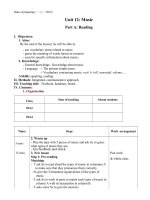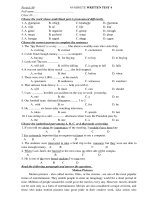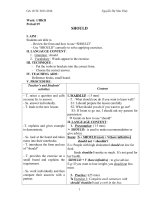GIÁO ÁN TIẾNG ANH LỚP 10 bam sat 10 12 + 13
Bạn đang xem bản rút gọn của tài liệu. Xem và tải ngay bản đầy đủ của tài liệu tại đây (114.58 KB, 6 trang )
Self-chosen - English 10
Date:…….../…………/……….
Period: 12
RELATIVE PRONOUNS
I. AIM : Students are able to
- Review the use of relative pronouns.
- Use relative pronouns correctly to solve applying exercises.
II. LANGAUGE CONTENT :
1. Grammar : Relative pronouns
2. Vocabulary : Words appear in the exercise.
III. PROCEDURE :
Teacher’s and Students’
activities
- T. introduces a small game and
explains its rule.
- T. writes an incomplete
sentence on the board and then
give an example to set a model.
- Ss. work individually, take
turns to repeat their friends’
sentences and then give their
own ideas.
- Ss. who can remember longer
and have more creative ideas
will win.
- Then, T. notices the
appearance of “who” in these
sentences above.
- T. leads to the new lesson.
- T. asks Ss. to reminds the use
of relative pronouns “who”, “
whom”, “ whose”, “which” and
“that”.
- Then, T. comes to a conclusion.
- T. gives examples to illustrate
for each case.
- Ss. look at the board and takes
notes into their notebooks.
Content
I. WARM UP : ( 5 mns)
Game : Who can remember longer?
- T. : Complete the following sentence with your own ideas.
An ideal friend is a person who……………………………….
Example : An ideal friend is person who is friendly.
S1: An ideal friend is person who is friendly and helpful.
S2: An ideal friend is person who is friendly, helpful and
humorous .
S3: An ideal friend is person who is friendly, helpful,
humorous and sympathy.
S4: An ideal friend is person who is friendly, helpful,
humorous , sympathy and ……………………..
- T. : Who is used to begin a relative clause, replace for a noun of
people.
RELATIVE PRONOUNS.
II. LANGUAGE CONTENT :
1. Presentation: ( 15 mns)
RELATIVE PRONOUN “WHO”, “ WHOM”, “WHOSE”
“WHICH” AND “THAT”
WHO is used to replace for nouns of people, functioning as a
subject or an object of the sentence.
E.g: Students who have good marks will receive presents.
WHOM is used to replace for nouns of people, functioning as a
an object of the sentence.
E.g: The doctor whom I was hoping to se wasn’t on duty.
WHICH is used to replace for nouns of things, functioning as an
object of the sentence.
E.g: Have you got a parrot which can speak five languages.
The book which you sent me yesterday is very interesting.
WHOSE is used to replace for possessive adjectives for both
things and people
Teacher : Nguyeãn Thò Thu Thuûy
Self-chosen - English 10
E.g: The man whose car was stolen is my father’s friend.
THAT can be used instead of WHO, WHOM and WHICH in
defining relative clauses.
- T. notices Ss. the following E.g: He works for a magazine which/ that is very popular in Italy.
points
NOTES :
- Relative pronouns stand right after the nouns they modify.
- Whose is followed after by a noun.
E.g: The man whose car was stolen is my father’s friend
2. Practice : (25 mns)
- T. provides the exercise on a
Exercise 1: Fill each blank with a suitable relative pronoun.
small board and explains the 1. The pianist ………….played at the concert last night is internationally
requirement.
famous.
2. Thomas raven is a physicist,………..book on time and space has been
- Ss. work individually and then translated into dozen of languages.
compare their answers with a 3. The house……………I was born and grew up was destroyed in an
partner.
earthquake ten years ago.
4. The girl………….is sitting in front of you now is my friend.
5. The letter…………..you sent to our customers last week contained
- After that, T. asks Ss. to give three spelling errors.
their answers and explains their 6. The table…………..legs are broken should be repaired.
choices.
7. We thoroughly enjoyed the music……………we had at the concert last
night.
8. The experiment……………..was conducted at the university of
- Ss. give out the answers in Chicago was successful.
front of the class.
9. The decision was postponed,……………was exactly what he wanted.
10. She isn’t the last person……………they sponsor.
- T. checks with the whole class.
- T. shows the exercise on a
small board and explains the
requirement and new words if
any.
- Ss. copy into their notebook
- Ss. work individually, then
compare their answers with a
partner.
Answers :
1. who
6. whose
2. whose
7. which
3. which
8. which
4. who
9. which
5. which
10. whom
Exercise 2: Combine the pairs of sentences, using a correct
relative pronoun.
1. The architect is brilliant. Marico works with him
2. The chair is antique. Sally inherited it from her grandmother.
3. I recently went back to Paris. It is still as beautiful as a pearl.
4. The man is an artist. I don’t remember his name.
5. Do you know the music? It is being played on the radio?
6. The students is from China. He sits next to me.
7. Rod Lee has won an Oscar. I know his sister.
8. The man is selling lottery tickets. He used to be very rich.
9. The paintings have been found. They disappeared from the
Teacher : Nguyeãn Thò Thu Thuûy
Self-chosen - English 10
- T. goes around the class to
offer help.
- T. calls on some Ss. to give
their answers on the board.
- Ss. go to the board and write
down their sentences.
- T. has other Ss. give comments
and corrective feedback.
- Then, T. gives final comments.
museum some time ago.
10. How did you know that man? I met him at the meeting last week.
Answers:
1. The architect whom Marico works with is brilliant.
2. The chair which Sally inherited from her grandmother is antique.
3. I recently went back to Paris, which is still as beautiful as a pearl.
(non-defining relative clause)
4. The man whose name I don’t remember is an artist.
5. Do you know the music which is being played on the radio?
6. The student who sits next to me is from China.
7. Rod Lee, whose sister I know, has won an Oscar. (non-defining
relative clause )
8. The man who used to be very rich is selling lottery tickets.
9. The paintings which disappeared from the museum some time ago
have been found.
10. How did you know that man, whom I met at the meeting last
week? (non-defining relative clause )
III. HOMEWORK : (1 mn)
-Ss. review the use of relative pronouns and make 5 sentences,
using them.
Self-evaluation
………………………………………………………………………………………………………………………………………………………………………………….................
………………………………………………………………………………………………………………………………………………………………………………………………………
Date:…….../…………/……….
Period: 13
RELATIVE PRONOUNS (cont)
I. AIM : Students are able to
- Review the use of relative pronouns.
- Distinguish defining relative clauses and non-defining relative clauses.
- Use relative pronouns correctly to solve applying exercises.
II. LANGAUGE CONTENT :
3. Grammar : Relative clauses : defining or non-defining
4. Vocabulary : Words appear in the exercise.
III. PROCEDURE :
Teacher’s and Students’
activities
Content
I. WARM UP : ( 5 mns)
Mini board: Match a part in column A with a suitable part in
- T. sticks a small board and column B and write a suitable relative pronoun on the space.
explains the task.
A
B
1. The taxi driver A. ………I saw last night wasn’t very
- Ss. work in pairs to find the
good.
Teacher : Nguyeãn Thò Thu Thuûy
Self-chosen - English 10
answers.
2. The movie
-Then, T. calls on some Ss. to
give their answers.
3. The director
- T. checks with the whole class.
- T. leads to the new lesson.
- T. shows a mini board to review
the use of relative pronouns.
- T. introduces two types of
relative clause.
- T. gives examples to illustrate
for each case so that Ss. can
engrave the lesson.
- Ss. look at the board and takes
notes into their notebooks.
4. The story
5. The man
B. ………. I spoke to at the party gave me
advice.
C. ………… took me to the airport was
friendly.
D. …………… got the most votes received
the Oscar.
E. …………… we are reading is called “The
Lotus Eater”
Answers:
1 – C (who)
4 – E (which)
2 – A (which)
5 – B (whom)
3 – D (who)
II. LANGUAGE CONTENT :
2. Presentation: ( 15 mns)
Subject
Object
Possessive
Person
who/ that
whom/ that
whose
Thing
which/ that which/ that
whose
DEFINING RELATIVE CLAUSES: are clauses that give essential
information to define or identify the person or thing we are talking
about.
Form: No commas are used in defining relative clauses.
E.g: The woman who spoke at the meeting was my sister.
NON-DEFINING REALTIVE CLAUSES: are clauses that tell us
more information about someone or something. The information in
these clauses are not essential.
Form: Non-defining relative clauses are always separated from
the rest of the sentence by commas.
E.g: Peter, who is a lawyer, talk persuasively.
Notes: In non-defining relative clauses, we cannot use “that”
instead of “who, whom, and which”.
We use non-defining relative clauses when the noun or phrase
before it is:
a) a proper noun : Here is Le Hong Phong high school, which
is one of the best in Vietnam.
b) something unique : Mars, which is very hot, is being
explored.
c) modified by a demonstrative pronoun (this, that, these,
those) : We all like that little boy, who is my next-door neighbour’s
son.
d) modified by a possessive adjective (your, his, her, my. their,
our…) : My pen, which looks like yours, has been stolen.
2. Practice : (25 mns)
- T. provides the exercise on a
Exercise 1: Fill each blank with a suitable relative pronoun, put
small board and explains the a comma where necessary.
Teacher : Nguyeãn Thò Thu Thuûy
Self-chosen - English 10
requirement.
- Ss. work individually and then
compare their answers with a
partner.
- After that, T. asks Ss. to give
their answers and explains their
choices.
- Ss. give out the answers in front
of the class.
- T. checks with the whole class.
- T. shows the exercise on a small
board
and
explains
the
requirement and new words if
any.
- Ss. copy into their notebook
- Ss. work individually, then
compare their answers with a
partner.
- T. goes around the class to offer
help.
- T. calls on some Ss. to give their
answers on the board.
- Ss. go to the board and write
1. I can’t find the book………………..you lent me last week.
2. He wrote a book ……………………………the critics disliked.
3. The management didn’t consider my application ………………I
thought was rather unfair.
4. Kevin Slob……………………..used to be a plumber is now a movie star.
5. Nam’s parents…………….are both retired now live in Binh Duong.
6. Lam…………….I’ve known for years is a very nice person.
7. The chair ………………….was broken has now been repaired.
8. Those people……………..live next door helped us move the furniture.
9. His second film………………..was released last week is called Big
Frank.
10. I met Loan last night with a friend ………………….is studying at Tran
Dai Nghia high school.
Answers :
6. which (no commas)
7. which (no commas)
8. which (………application, which……..)
9. who (Kevin Slob, who …………., is…………..)
10. who (Nam’s parents, who……………, now…………….)
11. whom (Lam, whom……………, is ………………)
12. which (no commas)
13. who (Those people, who …………., helped……….)
14. which (……film, which…………., is………….)
15. who (no commas)
Exercise 2: Combine the pairs of sentences, using a correct
relative pronoun.
1. My uncle Tom is coming to visit me. He lives in Manchester.
2. The people are very enthusiastic. They volunteer to do
charity work.
3. Peter’s sister is a nice person. I’ve known her for ages
4. I’ll introduces you to a man. His support is necessary for
your project.
5. Do you know that tall man? Our principle is talking to him.
6. The bed is very comfortable. We sleep in it.
7. Our teacher assigned us the homework. We had to finish it
within a week.
8. I’m going to be interviewed for my new job. That makes me
nervous.
9. This is my close friend. I talked to you about him last night.
10. We listened to her talk last night. It was really interesting.
Answers:
1. My uncle Tom, who lives in Manchester, is coming to visit
me.
2. The people who volunteer to do charity work are very
enthusiastic.
Teacher : Nguyeãn Thò Thu Thuûy
Self-chosen - English 10
down their sentences.
3. Peter’s sister, whom I’ve known for ages, is a nice person.
4. I’ll introduces you to a man whose support is necessary for
you project.
5. Do you know that tall man, whom our principle is talking to?
- T. has other Ss. give comments
6. The bed which we sleep in is very comfortable.
and corrective feedback.
7. Our teacher assigned us the homework which we had to
finish within a week.
8. I’m going to be interviewed for my new job, which makes
- Then, T. gives final comments.
me nervous.
9. This is my close friend, whom I talked to you about last
night.
10. We listened to her talk last night, which was really
interesting.
III. HOMEWORK : (1 mn)
-Ss. review the use of relative pronouns, distinguish defining
relative clauses and non-defining relative clauses, and make 5
sentences, using these structures.
Self-evaluation
………………………………………………………………………………………………………………………………………………………………………………….................
………………………………………………………………………………………………………………………………………………………………………………………………………
……………………………………………………………………………………………………………………………………………………………………………………………………..
Teacher : Nguyeãn Thò Thu Thuûy









